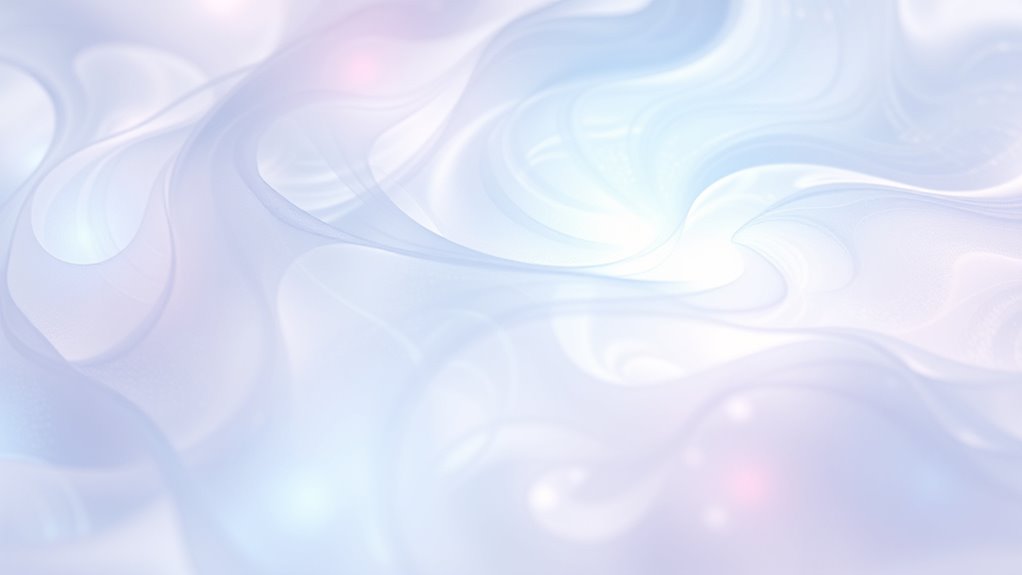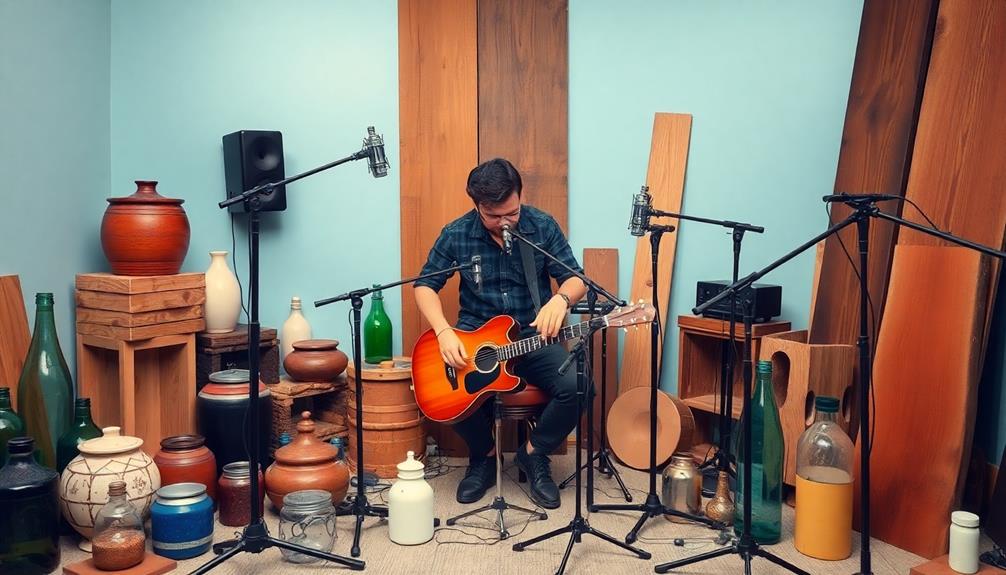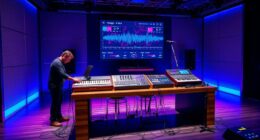To build evolving ambient textures with modulation, start by selecting a versatile synthesizer that allows you to layer different waveforms and employ multiple modulation sources like LFOs and envelopes. Use subtle filter sweeps, pitch shifts, and rhythmically synced LFOs to create movement. Layer modulated elements with spatial effects like reverb and panning to add depth. Experimenting with dynamic parameter changes keeps your soundscape lively and immersive. Keep experimenting further to discover endless atmospheric possibilities.
Key Takeaways
- Use multiple LFOs and envelopes to modulate filter cutoff, resonance, and pitch for dynamic, evolving pad textures.
- Incorporate granular synthesis to manipulate sound grains, creating intricate and organic movement within the pad.
- Layer sounds with varying spatial effects like reverb and panning to enhance depth and spatial complexity.
- Vary modulation depth and rate over time to prevent static textures and introduce subtle shifts.
- Combine rhythmic LFO gating and filter sweeps to produce pulsating, immersive atmospheres.
Understanding the Role of Modulation in Ambient Soundscapes

Have you ever wondered how ambient soundscapes feel so immersive and dynamic? The secret lies in modulation, which manipulates parameters like pitch, volume, and filter to create movement and depth. Spatial effects, such as reverb and panning, enhance the sense of space, making sounds seem to swirl around you. Modulation adds harmonic complexity, blending subtle shifts that evolve over time, preventing static textures. When you apply modulation wisely, it transforms simple pads into living, breathing atmospheres. These movements engage your auditory senses and draw you deeper into the soundscape. By understanding how modulation influences spatial effects and harmonic complexity, you gain the power to craft rich, evolving textures that captivate and transport your listeners. Engaging with sound design techniques can further elevate your ambient textures and create more immersive experiences.
Selecting the Right Synthesizer for Evolving Pads

Choosing the right synthesizer depends on your need for oscillator flexibility and modulation capabilities. You want an instrument that can create complex, evolving textures without hassle. By focusing on these features, you’ll find a synth that easily shapes your ambient soundscapes. Additionally, understanding the core personality traits of your instrument can help you select a synth that aligns with your creative style and workflow.
Oscillator Flexibility Options
To craft evolving pads that transform seamlessly over time, selecting a synthesizer with flexible oscillator options is essential. Look for one that offers a variety of oscillator waveforms, such as sine, saw, square, and pulse, to create rich, textured sounds. These waveforms serve as the foundation for your sound design, allowing you to layer and blend different tones. Additionally, a synthesizer with adjustable modulation depth for its oscillators gives you more control over how much the waveforms fluctuate, adding movement and complexity. This flexibility enables you to craft pads that subtly shift and evolve, avoiding static textures. By choosing a synth with diverse oscillator options, you set the stage for creating immersive, dynamic ambient sounds that breathe throughout your composition. Exploring oscillator tuning options can further enhance your ability to shape evolving textures with precision.
Modulation Capabilities
Since modulation is key to creating dynamic, evolving ambient pads, selecting a synthesizer with robust modulation capabilities is essential. Look for one that offers advanced options like granular synthesis and spectral processing, which allow you to manipulate sound textures in real-time. Granular synthesis lets you break sounds into tiny grains, enabling intricate shifts over time, while spectral processing enables you to shape the harmonic content creatively. These features give you the flexibility to craft rich, immersive textures that evolve organically. A synthesizer with extensive modulation options—such as multiple LFOs, envelopes, and routing—allows you to layer subtle changes, creating depth and movement. Prioritize instruments that support complex modulation routing to access truly evolving, ambient soundscapes. Additionally, understanding modulation techniques can help you optimize your sound design for more nuanced and expressive textures.
Basic Modulation Techniques for Dynamic Textures

Modulation techniques are vital for creating dynamic textures in ambient pads, adding movement and interest to static soundscapes. One effective approach is granular synthesis, where you manipulate small sound grains to produce evolving textures. By modulating the grain size, position, or density, you introduce subtle shifts that keep the sound lively. Additionally, filter modulation plays a pivotal role; adjusting filter cutoff and resonance over time creates movement within a sound. Using LFOs or envelopes to modulate filters can produce sweeping changes, transforming static sounds into immersive, breathing textures. These basic techniques form the foundation for more complex modulation strategies, helping you craft ambient pads that continually evolve and engage the listener. Incorporating dynamic contrasts can further enhance the emotional impact of your textures, making them more captivating and memorable.
Creating Movement With LFOS and Envelopes

LFOs (Low-Frequency Oscillators) and envelopes are powerful tools for creating movement in ambient pads. By modulating parameters like filter cutoff, you can produce smooth filter sweeps that evolve over time, adding richness to your sound. Using rhythmic gating with LFOs introduces pulsating textures, creating subtle rhythmic variations that keep the pad dynamic. Envelopes shape the amplitude and filter changes, allowing you to craft gradual progressions or sharp attacks. Combining these elements, you can generate shifting tonal colors and rhythmic pulses that breathe life into your ambient textures. The key is to experiment with different modulation rates and depths, ensuring the movement feels organic and engaging without overwhelming the overall atmosphere. Incorporating suspension upgrades can also enhance the physical feel of your soundscapes, making them more immersive. This approach keeps your pads evolving naturally and engrossing.
Layering and Blending Modulated Elements

Layering and blending multiple modulated elements can considerably enrich the texture of your ambient pads. By combining sounds with different spatial effects, you create a sense of depth and movement that draws the listener in. Incorporate rhythmic patterns subtly to add a pulse without disrupting the tranquil atmosphere. Use modulation to vary parameters over time, seamlessly merging textures into a cohesive whole. The key is to balance these elements, ensuring they complement rather than clash. When done well, this approach produces a lush, evolving soundscape with immersive qualities. Additionally, employing digital sound synthesis techniques allows for further customization and complexity in your textures.
Practical Tips for Crafting Immersive Atmospheres

To create immersive atmospheres, focus on layering textures thoughtfully so each element adds depth without cluttering the mix. Use modulation techniques like subtle vibrato or filter sweeps to introduce movement and keep the soundscape dynamic. These approaches help your ambient pads feel richer and more engaging for the listener. Incorporating curiosity-driven experimentation can also lead to discovering unique sound combinations that enhance emotional impact. Curiosity-driven experimentation encourages exploring new ideas and perspectives in sound design.
Layering Textures Effectively
When creating immersive atmospheres with ambient pads, the key is to combine textures in a way that adds depth without cluttering the soundscape. Use harmonization techniques to blend layers smoothly, ensuring each texture complements the others. Sound layering strategies help you build richness without overwhelming the listener. To evoke emotion, consider these tips:
- Vary the dynamics between layers for subtle shifts
- Use contrasting textures to create tension and release
- Maintain a balance between high and low frequencies
- Focus on complementary modulation to keep textures evolving naturally
- Be mindful of individual responses to different textures and how they influence the overall mood.
Modulation Techniques for Depth
By introducing modulation techniques into your ambient pad setup, you can add dynamic movement and a sense of evolving space. Modulation creates harmonic complexity and rhythmic variation, making your textures more immersive. Use slow filter sweeps, pitch modulations, or LFO-driven effects to subtly shift the soundscape over time. These techniques prevent your pads from feeling static, fostering a deeper emotional connection. Experimenting with different modulation depths and speeds allows you to craft progressions that evoke a sense of mystery or serenity. Here’s a quick overview of modulation options:
| Technique | Effect |
|---|---|
| Filter Sweeps | Adds evolving harmonic complexity |
| Pitch Modulation | Creates rhythmic variation and tonal movement |
| LFO Effects | Enhances spatial depth and dynamic interest |
Additionally, understanding how sound vibrations influence cellular regeneration and overall health can inspire more nuanced modulation choices that evoke a sense of healing and tranquility.
Advanced Modulation Strategies for Unique Sound Design

Advanced modulation strategies open new domains of creativity in ambient pad sound design, allowing you to craft textured, evolving soundscapes that stand out. Techniques like granular synthesis and spectral processing enable you to manipulate sound at a fundamental level, creating intricate textures and shifting tones. By modulating parameters dynamically, you can generate lush, unpredictable layers that evoke deep emotion. Experiment with spectral processing to reshape timbres in real-time, and employ granular synthesis to break sounds into tiny grains for rich, evolving textures. These approaches push your sound design beyond traditional methods, fostering unique atmospheres.
- Evoke a sense of wonder with shifting spectral textures
- Create immersive, hypnotic sound layers
- Infuse your pads with organic, unpredictable motion
- Build emotional depth through complex modulation
Frequently Asked Questions
How Do Different Modulation Sources Affect Ambient Pad Textures?
Different modulation sources shape ambient pad textures by influencing oscillation types and modulation depth. When you choose different oscillation types, like sine or square waves, you create varied movement and complexity in the sound. Adjusting modulation depth controls how much these sources affect the pad, making the textures more subtle or intense. By experimenting with these parameters, you can craft evolving, immersive sounds that add depth and atmosphere to your music.
What Are Common Mistakes to Avoid When Creating Evolving Sounds?
When creating evolving sounds, avoid common mistakes like overusing modulation depth, which can cause instability or unwanted noise. Pay careful attention to filter design; overly complex or improperly set filters can muddy your sound. Keep modulation subtle at first, then gradually increase it to add movement. Also, don’t forget to automate parameters smoothly, ensuring your textures evolve naturally without abrupt changes that distract the listener.
How Can I Automate Modulation Parameters for Dynamic Changes?
To automate modulation parameters for dynamic changes, you should start by syncing your LFOs with your project’s tempo to keep things cohesive. Use envelope shaping to control how your modulation evolves over time, creating more natural and expressive textures. Make small, deliberate adjustments to automation curves, and regularly listen to how changes affect your sound, ensuring your evolving textures stay engaging and well-balanced throughout your track.
Which Effects Best Complement Modulated Ambient Pads?
To enhance your sound design, choose effects that complement modulation techniques on ambient pads. Reverb and delay add spaciousness and depth, making your textures feel more immersive. Filters, especially slow-moving low-pass or high-pass, can shape the evolving soundscape. Chorus and phaser effects introduce movement and richness, while subtle distortion adds warmth. Experiment with these effects together to create dynamic, evolving textures that respond beautifully to modulation automation.
How Do I Troubleshoot Phase Cancellation Issues in Layered Textures?
Troubleshooting phase cancellation issues is like untangling a knot in your headphones. You should first check phase alignment—make sure your layered sounds are in sync. Then, examine frequency overlap; if two sounds share similar frequencies, they can cancel each other out. Adjusting the phase or EQ can help minimize these issues, resulting in clearer, more immersive textures. Keep experimenting until your layers blend seamlessly without cancellation.
Conclusion
Think of building ambient pads like tending a garden—each modulation technique is a seed that, when nurtured, blooms into evolving textures. By carefully selecting your tools and layering your sounds, you craft a lush landscape of soundscapes that breathe and grow. Embrace the process, experiment with movement, and watch your sonic garden flourish into a vibrant, immersive world. With patience and creativity, your ambient soundscape becomes a living, breathing masterpiece.










